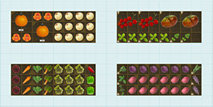How to grow Turnip?
- Latin Family: Brassicaceae
- Latin Genus: Brassica
- Ease of Growing: Moderate
- Growing Type: Biennial
Turnips are a fast growing and surprisingly versatile crop. The roots provide a substantial root vegetable, the leaves can be used as nutritious greens, the flower buds can be used like broccoli (they are popular in Italy under the name Broccoli Raab), and the seeds can be sprouted like alfalfa.
Turnip History
It is believed this cool season [biennial] was domesticated independently in Afghanistan and in the Eastern Mediterranean. In Europe, the large swollen roots have been grown for centuries as food for animals and poor humans. They were scorned by the better off classes as only fit for animals and still carry a slight stigma to this day. In Asia, the roots are looked upon very differently and it is a very important crop in both China and Japan. In those countries a whole range of varieties exist.
Soil Preference
- PH (min/max): 6.0 - 7.5
- PH Ideal (min/max): 6.5 - 6.8
The Brassicas in general do well on fairly [neutral], or even somewhat [alkaline] soil. They don't like acid soils, as anything below pH 6.5 encourages the notorious [Clubroot]. Turnips need to grow quickly for best quality, which requires a rich, loose, well drained (but moisture retentive) soil.
Turnips are vulnerable to boron deficiency, but this shouldn't be a problem if you add lots of [organic matter].
How to care for Turnip?
The best turnips are those that have grown rapidly, which can only occur if the plants have everything they need in the way of nutrients, light and water.
Water
Turnips don't need a lot of water, but it should be available constantly and not fluctuate too much. If the soil gets too dry, they can get woody and may even [bolt].
Fertilizer
Low nitrogen. Low phosphorous. Low potassium.
Turnips don't require a lot of nitrogen, unless you are growing them for greens, as this encourages foliage growth rather than root growth.
Seeds
Seed Viability: 3 - 5 Years
Germination Percentage: 75.0
Turnips are cross pollinated by insects (that's why they have pretty flowers), so only one variety can be flowering within a half mile. The most common method of obtaining seed is to plant it in late summer, protect it over the winter (inside or outside), and allow it to flower in spring. It should be planted in blocks so insects are likely to visit many plants without going to other plants nearby.
You collect the dry pods when they are ripe (they shatter easily so watch carefully), sift out the seeds, dry further and store.
In milder areas turnips may self-seed if given the opportunity.
Light
Sun: min. 6 hours daily
Full sun.
Conditions:Cold, Cool
Season:Short Season, Long Season
Storage
In milder areas they can be left outside under mulch.
Storage Req: Ground
Storage Temp: 32-45°F
Storage Length: days
The root can be cut into cubes and frozen.
Storage Req: Freezer
Storage Temp: 32°F
Storage Length: days
The roots can be stored in a root cellar at 34 to 40˚ F (if it’s warmer than this they will eventually start growing).
Storage Req: Cool, Moist
Storage Temp: 35-40°F
Storage Length: 1-90 days
The roots can be stored in a plastic bag in the refrigerator.
Storage Req: Refrigerator
Storage Temp: 35-40°F
Storage Length: 14-28 days
Problems
Bolting
[Bolt]ing is by no means unique to Turnips. It happens to many [biennial] crops when they are exposed to temperatures below 50˚ F for two weeks and then it gets warm. The plant thinks winter has passed and so starts the flowering process. For this to happen the plant must have a stem diameter of at least 1/4˝.
Turnip Types
- Turnip
The commonly grown turnips have golden, white or purple skin and white flesh. Their flavor may be fairly sweet or pungent depending upon the variety and growing conditions. The leaves are also quite popular cooked, and some varieties of turnips are grown solely for the greens. If the growing conditions are good, turnips can be one of the fastest growing crops.
Pests
- Cabbage Root Maggot
- Deer
- Cabbageworms
- Slugs and snails
- Lace Bug
- Aphids
- Birds
- Cutworms
- Gophers
- Nematodes
- Thrips
Diseases
- Boron
- Scab
- Wirestem
- Clubroot
- Blackleg, Aerial Stem Rot
- Damping Off
- Downy Mildew
